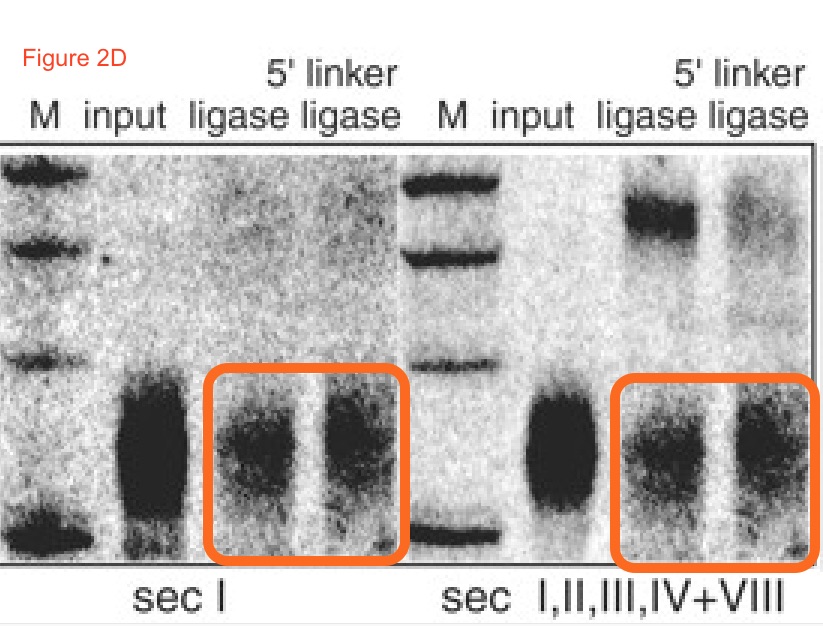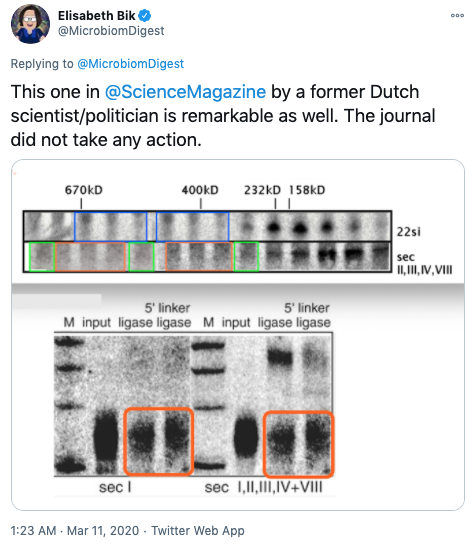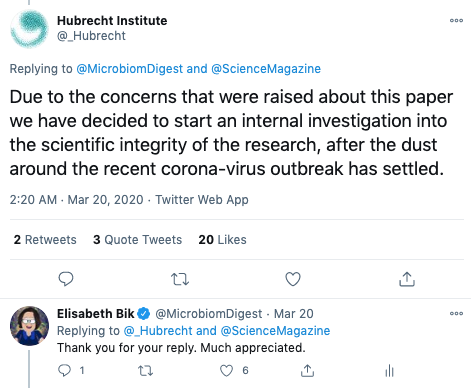A 2007 paper published in Science — in which I found image irregularities back in 2015 — has finally been retracted. For five long years, the journal took no action. But after I tweeted about the case, it eventually acted.
During my investigation of 20,000 biomedical papers (published in 2016 in mBio and — yes — I scanned every one of them by eye), I found around 800 (4%) that contained inappropriately duplicated photos. It was one of these papers that was published in 2007 in Science.
Secondary siRNAs Result from Unprimed RNA Synthesis and Form a Distinct Class – Titia Sijen, Florian A. Steiner, Karen L. Thijssen, Ronald H. A. Plasterk – Science (2007) Vol. 315, Issue 5809, pp. 244-247 – DOI: 10.1126/science.1136699
Top institute and researchers
The authors of the 2007 Science paper were affiliated with the Hubrecht Laboratory, which proudly proclaims itself one of the best institutes in the world. The Hubrecht Institute focuses on developmental and stem cell research.
At the time the Science paper was published, the senior author, Ronald Plasterk, was the Hubrecht Institute’s Director. Back then he was among the top researchers in the Netherlands, and had been awarded the prestigious Spinoza Prize by the Dutch Organization for Scientific Research in 1999.
In February 2007, a month after publication of the Science paper, Plasterk left his position as the Hubrecht Lab’s Director to become the Minister of Education, Culture and Science for the Labour Party in the Netherlands. He remained a politician until 2017, after which he became the CSO of a medical company, and a professor at the University of Amsterdam.
The first author, Titia Sijen, moved on to work as a senior scientific researcher at the Netherlands Forensic Institute in 2007, and has recently been appointed a professor at the University of Amsterdam.
The other, shared, first author, Florian A. Steiner, is currently an assistant professor at the University of Geneva.
Duplications in three figures
Three of the figures in the 2007 Science paper appeared to have duplications. These were not simple repeats, for example where the same photo was mistakenly included twice. Instead, the photos contained repetitive elements, with the same area appearing to be visible more than once within the same image. This is something really unexpected. It would be like looking at a photo of a dinner party and seeing the same person twice, in precisely the same pose. Such duplications within one photo have a very small chance of happening naturally, so one might legitimately conclude that an image like this had been knowingly manipulated.
Figure 2D includes two panels that appear to contain the same RNA bands in the lower area of the photos, while the upper parts of the lanes are different. I have marked these duplications below with red boxes:

Supplemental Figure S1C appears to show the same lane twice in the right-most panel (blue boxes):

And Supplemental Figure S3C appears to show multiple repetitive areas, which I have marked with blue, green, and orange boxes:

Reported to the journal in 2015
I was pretty shocked when I found these problems, especially when I realized who the last author was. Plasterk was a top researcher in the Netherlands. In fact he was one of my science role models at the start of my career, so it was distressing to discover that one of his papers contained problematic images.
Nevertheless, I reported this paper — just as I had the other 800 with duplicated figures that I’d uncovered in 2014 and 2015.
In April 2015, I wrote an email to the Science editors to detail my concerns about the Sijen et al. (2007) paper, together with another ten Science publications I had found during my scan. A couple of months later — in October 2015 — I also posted my findings anonymously onto PubPeer, as Peer 1, with notifications to three of the authors.
Then I waited.
And nothing happened.
Waiting for five years
Over two years later, in September 2017, I asked the Science editors for an update on the eleven papers that I had reported. The Deputy Editor & International Managing Editor replied, promising to send me an update later that week.
The update never came. In fact I waited a couple more years.
Now, I’m a patient person. But five years seemed an awfully long time to wait. So in March 2020, I tweeted about the paper’s problematic images, a full five years after reporting them to Science. This was part of a Twitter thread on unaddressed image problems in top scientific journals.

Institute and journal finally respond
Pepijn van Erp, a Dutch scientist and skeptic, picked up on the story. Realizing who the senior author was, he found the PubPeer post where I’d written about the duplicated images.
A couple of days after my tweet, van Erp wrote an article about these findings (in Dutch). He said it was embarrassing that the problems had not been addressed after so many years. His article finally seemed to get things moving.
The Hubrecht Institute replied to my tweet on March 20, explaining that they would start an investigation.

Science paper retraction
Last week, I suddenly learned that the Science paper was to be retracted. But I didn’t get this news from the journal, nor from the authors, nor from the institute. Instead, I heard about it from the authors of Retraction Watch, who published ‘Science retracts paper co-authored by high-profile scientist and former Dutch minister‘ on November 19, the day of the retraction.
It was peculiar, and also not in line with COPE guidelines, that neither the journal nor the institute informed me. It was also regrettable that the journal took so long to take action, and only did so after I tweeted about it, five years after officially reporting it. In spite of this, though, it is good to know that the problematic images have finally been addressed.
The Retraction Notice confirms my findings of “duplications in Fig. 2D and supplementary figures S1C and S3C” in the Sijen et al. paper. It also states that the authors were unsuccessful in finding the original blots: “We attempted to find the original data from 2007, but all authors have left the Hubrecht Institute, where the work was performed, and the data could not be located.”
The Retraction Watch article quotes last author Ronald Plasterk, who provides a little more detail.
“My former institute, the Hubrecht Institute, informed me earlier this year of a PubPeer posting. When I saw the posting I concluded that it seemed indeed there was something wrong with the negative control lanes in a figure, and I contacted the other authors. The first author went to the archives of the Hubrecht to search for the original autoradiograms, but could not find them. We informed the editor of Science. While the conclusions of the paper have since been repeated and confirmed by us and others, we retract the paper, because of the absence of a correct negative control in that figure.”
From Plasterk’s response, it seems that neither he nor the Hubrecht Institute were aware of the concerns until my tweet in March 2020. If this is so, it means that Science failed to contact both the authors and their institute following my email in May 2015. This is sadly not in line with COPE guidelines, which advise journal editors to immediately contact a paper’s authors and/or institutions after receiving data concerns from a reader.
The editors at Science still haven’t contacted me to explain these five years of inertia.
But I’d love to talk to them.
I have ten other Science papers to ask them about.
News articles
- Ronald Plasterk moet Science-artikel terugtrekken – Marcel aan de Brugh – NRC.nl
- Science trekt wetenschappelijk artikel Ronald Plasterk terug – George van Hal – de Volkskrant
- Oud-minister Plasterk in de fout met wetenschappelijk artikel – Peter Winterman – Algemeen Dagblad
- Ronald Plasterk moet wetenschappelijk artikel terugtrekken – Hella Hueck – FD
- Science trekt paper Plasterk terug wegens gedupliceerde foto’s – Sterre van der Hee – Folia.nl
- Former Minister’s Paper Retracted – GenomeWeb

See also https://www.folia.nl/actueel/141961/science-trekt-paper-plasterk-terug-wegens-gedupliceerde-fotos
LikeLike
A link to that article was already included in the list of News Articles.
LikeLike
Now the more difficult part: exposing reams of covert junk science plaguing elite journals contributing to ponzi like schemes and functioning in an almost parallel world to real science. I wonder how much science would really suffer if one removed 80% of papers published in top tier journals in the last 2 decades or would it actually excel encouraging a shift of focus to less sexy papers without patented technologies.
LikeLike